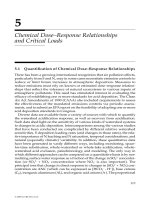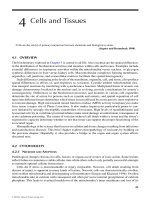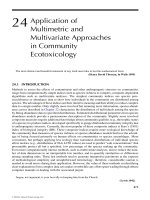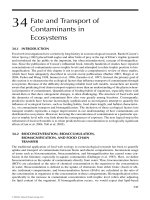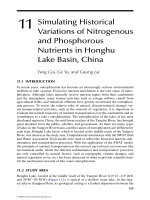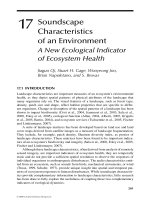LANDSCAPE ECOLOGY A Top-Down Approach - Chapter 5 pdf
Bạn đang xem bản rút gọn của tài liệu. Xem và tải ngay bản đầy đủ của tài liệu tại đây (183.18 KB, 15 trang )
© 2000 by CRC Press LLC
Part II
The Ecology of Landscapes
© 2000 by CRC Press LLC
5
The Ecology in Landscape Ecology
Jim Sanderson and Larry D. Harris
CONTENTS
Landscape Effects
Tropical Forests
Boreal Forests
Fragmentation and Bird Communities
Atmospheric Connectivity
Climate Change and Grasshoppers in Australia
The Ecology in Landscape Ecology
Grazing and Ecosystem Functioning
Deer and Songbirds
Coherent Landscape Ecology Paradigm
Biodiversity
Protecting Biodiversity “Hot Spots”
A Top Predator in a Highly Fragmented Human-Dominated
Landscape
Exercises
What is the ecology of landscapes? Why should we study landscape ecology?
Landscape ecology is the study of processes and organisms that promote and
maintain the natural functioning of more than one ecosystem. When mobile
organisms and processes are decoupled from ecosystem processes by frag
-
mentation or loss of connectivity, natural ecosystem processes change, often
in catastrophic ways harmful to humans. Species identities, numbers of spe
-
cies, community composition, and physical and chemical processes in eco-
systems change. Often, a loss of biodiversity results. The ramifications to
conservation of the biological resources of the earth are clear. To maintain nat
-
urally functioning ecosystems landscape connectivity must be preserved.
Earlier we wrote that advances in landscape ecology will come from the
study of landscape effects and also the effects mobile organisms have on
landscapes. Many studies show that the spatial structure of landscapes has
important effects. The effects mobile organisms have on landscapes have
© 2000 by CRC Press LLC
received relatively less attention. With the emergence of a new appreciation
for keystone species (Simberloff 1998) and ecosystem engineers (Jones et al.
1997, 1994; Lawton 1994) and the recognition that multilevel evolution (Wil
-
son 1997) takes place in local communities, we are confident all organisms
will be seen as important contributors to the ecology of landscapes.
Landscape Effects
Tilman and Kareiva (1997) presented in detail the importance of spatial struc-
ture in population dynamics and species interactions. The collected readings
demonstrated repeatedly that space played a pervasive role in determining
stability, patterns of diversity, invasion of exotics, coexistence, and pattern
generation. Many others in excellent texts on landscape ecology also
described the profound influence space has on organisms and processes (Bis
-
sonette 1997; Lidicker 1995; Hansson et al. 1995). The fundamental paradigm
for the study of landscapes espoused by Forman and Godron (1986) was the
patch-matrix-corridor model. Lidicker (1995, p. 15) stated the paradigm for
landscape ecology precisely:
We now have a conceptual framework in which to analyze the influence
of habitat patch size and shape, the role of juxtaposition of different kinds
of communities, the importance of corridors among patches, the influ
-
ence of edge effects, and the impact of varying proportions and qualities
of different community-types in a landscape.
Hansson (1995) provided an excellent historical summary of research
efforts in landscape effects. We believe that spatial effects are not the full story
told by landscape ecology. How, for instance, will the quantification and sort
-
ing of landscape patterns illuminate functional organization? First, however,
we must gain an appreciation for these effects. Here we emphasize that frag
-
mentation is a landscape process that impacts ecosystem processes. In 1985,
habitat fragmentation was seen as the most serious threat to biological diver
-
sity because fragmentation (1) reduced available habitat and (2) increased
insularization (Wilcox and Murphy 1985). We now know that the effects of
fragmentation go well beyond those originally envisioned (Harris 1988).
Tropical Forests
Laurance et al. (1997) found that rain forests in Amazonia were not subjected
to frequent fires, so soil sequestration of C may not be as important as in other
© 2000 by CRC Press LLC
latitudes. However, massive quantities of C were sequested in the biomass of
tropical forests. Laurance et al. found that rain forest fragments in central
Amazonia experienced dramatic loss of above-ground biomass not offset by
recruitment. Forest fragments suffered from enhanced negative edge effects
such as increased wind turbulence and microclimate changes. Fully 36% of
the above-ground biomass within 100 m of edges was lost in the first 10 to 17
years of fragmentation. This decline in biomass, the authors suggested, could
lead to increased CO
2
levels in the atmosphere.
Boreal Forests
Wardle et al. (1997) considered the influence of island area on ecosystem
properties. Recall that the Theory of Island Biogeography (MacArthur and
Wilson 1967) suggested that occurrence and abundance of species were pro
-
portional to island area. If individual species were important in determining
ecosystem-level properties then islands with different areas should contain
different ecosystem-level attributes. Wardle et al. examined 50 islands of the
same age and origin ranging in size from 0.02 to 15 ha found within two lakes
in the northern boreal forest zone of Sweden.
The main episodic event on the islands was wildfire caused by lightning
strikes. Lightning struck larger islands more frequently than smaller islands.
Larger islands had more earlier-successional plant species which dominate in
the presence of regular wildfire, whereas smaller islands showed a greater
abundance of successional species that occurred in the prolonged absence of
fire. Smaller islands had higher concentrations of water-soluble phenolics,
reduced microbial biomass, and less microbial activity in humus. Reduced
rates of decomposition and mineralization of litter were also found on
smaller islands. The inhibition of soil biotic processes on smaller islands
probably contributed substantial accumulation of humus found on them.
The smallest islands contained ten times more humus than did the largest
islands. Wardle et al. concluded that island area was critical in regulating key
ecological processes.
With increasing island size there was a distinct trend of an increasing pro-
portion of organic carbon bound in living organisms, especially trees. Wild-
fire was thus of critical importance in reversing C lockup in boreal forest
ecosystems. Deliberate anthropogenic suppression of fires in boreal forests
had the potential to lead to retardation of soil biological processes and sub
-
stantial terrestrial C sequestration. Boreal forests play a globally significant
role in the C cycle, and fire suppression likely adds to carbon buildup in the
atmosphere.
These results show that ecosystem properties depend on island size and
hence are applicable to human-created fragmented forests. As landscapes
become disarticulated episodic events such as fire occur less often, leading to
© 2000 by CRC Press LLC
changes in vegetation characteristics and community composition that alter
ecosystem processes. Wardle et al. showed that global carbon sequestration
in soils was enhanced by more frequent fires and so we must be led to con
-
clude that fragmentation leads to increased levels of atmospheric CO
2
.
Fragmentation and Bird Communities
The effects of forest fragmentation on forest bird communities was docu-
mented by Robinson et al. (1995). Nest predation and parasitism by brown-
headed cowbirds (Molothrus ater) increased with forest fragmentation in nine
midwestern U.S. landscapes that varied from 6 to 95% forest cover. Observed
reproductive rates were low enough for some species in the most fragmented
landscapes to suggest that their populations were sinks that depended for
perpetuation on immigration from reproductive source populations in land
-
scapes with more extensive forest cover.
Many neotropical migrant birds were suffering population declines from
causes that may include the loss of breeding, wintering, and migration stop
-
over habitats (Robinson 1993). Habitat fragmentation may allow higher rates
of brood parasitism by cowbirds and nest predation (Gates and Gysel 1978;
Temple and Cary 1988). Cowbirds lay their eggs in the nests of other “host”
species, which then raise the cowbirds at the expense of their own young.
Populations of cowbirds and many nest predators were higher in frag-
mented landscapes where there was a mixture of feeding habitats and breed-
ing habitats. In landscapes fragmented by agricultural fields, levels of nest
predation and brood parasitism were so high that many populations of forest
birds in the fragmented landscapes were likely to be population “sinks” in
which local reproduction was insufficient to compensate for adult mortality
(Pulliam 1988). As landscapes become increasingly fragmented, this repro
-
ductive dysfunction could cause regional declines of migrant populations.
Robinson et al. (1995) tested the hypothesis that the reproductive success of
nine species of forest birds was related to regional patterns of forest fragmen
-
tation in Illinois, Indiana, Minnesota, Missouri, and Wisconsin. Cowbird par-
asitism was negatively correlated with percent forest cover for all species.
Most wood thrush (Hylocichla mustelina) nests in landscapes with less than
55% forest cover were parasitized. In some landscapes, there were more cow
-
bird eggs than wood thrush eggs per nest. In contrast, cowbird parasitism
levels were so low in the heavily forested landscapes that cowbird parasitism
was unlikely to be a significant cause of reproductive failure (May and Rob
-
inson 1985).
Levels of nest predation also declined with increasing forest cover for all
species. Three ground-nesting warblers, the ovenbird (Seiurus aurocapillus),
worm-eating warbler (Helmitheros vermivrus), and Kentucky warbler (Oporr
-
nis formosus) and two species that nest near the ground in shrubs, the hooded
© 2000 by CRC Press LLC
warbler (Wilsonia citrina) and the indigo bunting (Passerina cyanea) all had
extremely high (6% or higher) daily predation rates in the most fragmented
landscapes. Of the 13 cases of daily predation rates exceeding 7%, 12 were in
the 4 most fragmented landscapes. Fragmentation at the landscape scale thus
affected the levels of parasitism and predation on most migrant forest species
in the midwestern U.S. In more fragmented landscapes the cowbird popula
-
tions may be more limited by the availability of hosts and may saturate the
available breeding habitat, resulting in high levels of parasitism even in the
interior of the largest tracts in Illinois. Therefore, landscape-level factors such
as percent forest cover determined the magnitude of local factors such as tract
size and distance from the forest edges, a result consistent with continental
analysis of parasitism levels (Hoover and Brittingham 1993).
Nest predators such as mammals, snakes, and blue jays (Cyanocitta cristata)
likely have smaller home ranges than cowbirds and may therefore be more
affected by local rather than by landscape-level habitat conditions. Small
woodlots in agricultural landscapes had high populations of raccoons (Pro
-
cyon lotor). Censuses in both Missouri and Wisconsin showed blue jay and
crow (Corvus brachyrhynchos) abundances to be higher in fragmented regions.
Parasitism levels of wood thrushes, tanagers, and hooded warblers and pre
-
dation rates on ovenbirds and Kentucky warblers were so high in the most
fragmented forests that they were likely population sinks.
Robinson et al. (1995) suggested that a good regional conservation strategy
for migrant songbirds in the Midwest was to identify, maintain, and restore
the large tracts that were most likely to be population sources of songbirds.
Further loss or fragmentation of landscapes could lead to a collapse of
regional populations of some forest birds. Increasing fragmentation of land
-
scapes was likely contributing to the widespread population declines of sev-
eral species of forest birds.
Spatial structure, however, is not the only factor influencing ecosystem pro-
cesses. Herbivory, biodiversity, atmospheric connectivity, and climate change
also influence ecosystem processes.
Atmospheric Connectivity
Physical processes operating over large areas such as El Niño events are often
overlooked when studies of metapopulations in fragmented landscapes are
undertaken. One reason might be that ecological studies typically begin as
bottom-up enterprises with site selection and organism autecological studies,
for instance. Regional processes, however, are gaining more attention in eco
-
logical studies. Studies performed in the White Mountains of New Hamp-
shire would be less valuable if the effects of acid rain were not considered.
Long-term studies at the Hubbard Brook Experimental Forest, a long-term
ecological research station, have shown that vegetation stopped growing in
© 2000 by CRC Press LLC
1987 and that the pH of many regional streams remained below normal (Lik-
ens et al. 1996). Prior to the 1970 Clean Air Act and the 1990 amendment, acid
rain deposition was blamed for reacting with soil calcium and magnesium,
causing trees to cease adding biomass. Moreover, even though acid rain
caused by fossil fuel consumption became less of a problem, soils and hence
forests were not expected to recover rapidly. The number of species lost in
lakes due to acidification may be substantial. A testable hypothesis would be
that insect, reptile, and bird populations occupying the forests of the north
-
east that have suffered acid rain deposition have less reproductive success
compared to those living in unaffected forests.
Climate Change and Grasshoppers in Australia
Birch (1957) documented the role of weather in determining the distribution
and abundance of the grasshopper, Austroicetes cruciata, in Australia.
Weather, Birch argued, might also be important in determining the qualita
-
tive composition of a population, affecting survival and reproductive capa-
bilities. Birch was careful to add that factors other than weather were also
important in determining the numbers of many animals. Local weather pat
-
terns are, in part, determined by landscape features.
The distribution of the grasshopper in the southwestern portion of Austra-
lia where outbreaks of the insect occurred were delineated by rainfall and
evaporation contours. That is, north of a particular soil moisture contour the
soil was too dry to support grasshoppers. South of another contour, the soil
was too wet for grasshoppers. Birch showed that the contraction and expan
-
sion of the grasshopper belt in a north–south direction was associated with
fluctuations of weather. Previously, Andrewartha and Birch (1954) were able
to estimate where outbreaks were likely to occur given moisture data from
previous years. Previously, an outbreak had occurred in 1937, but had disap
-
peared by 1938 and for several years thereafter.
Birch suggested that fluctuations in weather and other components of the
environment and spatial patchiness determined whether or not outbreaks
occurred. Understanding spatial heterogeneity and variable weather condi
-
tions over time were crucial to predicting when and where grasshopper out-
breaks occurred. By considering the demographic characteristic of the
grasshopper and tying their life history stages to the environment, Birch
argued that weather did indeed play a critical role in grasshopper outbreaks.
He strengthened his case adding that grasshopper populations further north
had been exterminated by severe weather, while further south small popula
-
tions were able to survive during unfavorable times, but outbreaks were not
known to occur. Any latitudinal changes in weather would favor one popu
-
lation over another so that the species was protected against extinction, at
least over ecological time and in the absence of human alterations to the land.
© 2000 by CRC Press LLC
Although establishing a reserve to protect an insect pest is unlikely, the
implications of such a task were illuminated by Birch. Had we knowledge of
only a few years worth of distribution data the likely possibility exists that we
might have established a reserve outside the prime contours of the most
favorable areas. The reserve would have to be big enough to encompass areas
where grasshoppers are rarely seen except in exceptional years. Suggesting
that saving 99.9% of the area occupied by grasshoppers over a limited time
period would most likely fail because the vagaries of weather might cause
dramatic consecutive range shifts outside protected areas. We would, in fact,
be forced to set aside a large heterogeneous, contiguous area with enough
north–south extent to include areas that most often do not support any grass
-
hoppers. Preserving a “hot spot” in the center of prime habitat simply would
not work for the grasshopper.
The Ecology in Landscape Ecology
The above examples are what we refer to as landscape effects. Specifically, the
arrangement of space affects the collective and emergent properties of organ
-
isms (Bissonette 1997) and hence ecosystem properties. Fragmentation is a
spatial feature that also affects ecosystem properties as does grazing, climate
change, and atmospheric transport. However, we believe this work begs the
question: What effect do organisms have on the ecology of this space?
Answering this question for mobile organisms is fundamental to closing the
circle of research on the ecology of landscapes. Johnston (1995) states so
clearly and simply the essence of landscape ecology that we need only repeat
her opening paragraph slightly modification by omitting references:
Studies of animal-patch interactions have generally focused on how ani-
mals are affected by patchy habitats rather than how they create them.
Scientists who observe animal activities that may alter habitat usually
quantify and interpret those behaviors in terms of the life history of the
animal, rather than consequences to the landscape, hence it is often as
-
sumed that their influence is minimal. However, there is growing evi-
dence of the ability of animals to influence landscape pattern and process.
Bowyer et al. (1997) in their opening paragraph agree:
An increasing body of evidence suggests these large herbivores play a cru-
cial role in determining the structure and function of the ecosystem they in-
habit. Moreover, we contend that the role that moose and other large
herbivores play in ecosystem processes has been neglected by many ecolo
-
gists and that future advances in ecosystem science will require integrating
© 2000 by CRC Press LLC
the behavior and population ecology of large mammals into the existing
paradigms of landscape ecology.
We prefer to include all mobile organisms into the paradigm. In addition to
Johnston (1995) and Bowyer et al. (1997) contributions to this paradigm have
been made (Pastor et al. 1998; Nummi and Pöysä 1997; Johnston et al. 1993;
Johnston and Naiman 1990; Naiman 1988; Botkin et al. 1981; Zlotin and Kho
-
dashova 1980; Harris and Fowler 1975; Belsky 1995). Landscape ecology
includes the study of landscape effects on organisms and the top-down
effects of mobile organisms on ecosystem processes and the creation and
maintenance of spatial heterogeneity. One need only consider the ability of
mobile organisms to disperse seeds, for instance, to realize organisms have
often profound impacts on the landscape.
Grazing and Ecosystem Functioning
For two years, McNaughton et al. (1997) studied nitrogen (N) and sodium
(Na) recycling by nonmigratory grazing herbivores in Serengeti National
Park, Tanzania. Grazers preferred forage rich in minerals that were important
to late-stage pregnancy, lactation, and growth of young animals. Two
hypotheses described this phenomenon: grazers foraged on vegetation sup
-
ported by nutrient-enriched soils, or grazing augmented nutrient availability.
McNaughton et al. found no evidence of general soil differences in study
plots used or avoided by grazers that did not migrate.
Concentrations of Na were found to be universally and substantially
higher in soils of animal concentration areas. McNaughton et al. concluded
grazing increased Na supply from soils by a factor of 10. The net N mineral
-
ization rate in soils supporting dense resident animal populations was over
twice that of areas where animals were uncommon. Herbivory by Serengeti
grazers accelerated mineralization of N and Na, both important in animal
nutrition.
Mammalian herbivores co-evolved with grasslands and their grazing
accelerated nutrient cycling. Overgrazing of grasslands commonly associ
-
ated with the replacement of free-ranging wild herbivores with livestock
often causes the replacement of highly palatable forages with plant species of
lower nutritional quality and decomposibility. McNaughton et al. concluded
naturally occurring terrestrial grazers modified ecosystem processes in ways
that alleviated nutritional deficiencies. This study also showed that acceler
-
ated nutrient cycling was an important property of habitats critical to large-
mammal conservation.
Pastor et al. (1998) studied moose foraging and plant communities on Isle
Royale, Michigan. Moose have been studied by several research teams in
other geographic areas. Because moose are large browsers in comparatively
© 2000 by CRC Press LLC
less diverse forests their top-down effects are possible to measure. McNaugh-
ton et al. (1997), Naiman et al. (1988), and others found that herbivores alter
ecosystem functioning, change species composition in communities, modify
nutrient cycling, and hence productivity, thereby changing landscape struc
-
ture. A high density of moose, 3.7/km
2
, occurred in the study area of Pastor
et al. Because moose arrived on Isle Royale at the start of the 20th century
their possible effects have taken place quite rapidly.
Other factors such as aspect, topography, and beavers might also have
caused patterns in landscapes. Pastor et al. concluded, however, that there
were no differences in nitrogen availability or browse consumption due to
slope, aspect, underlying bedrock, fire history, or glacial history. Moose
avoided spruce and only lightly browsed balsam fir. Thus, these trees were
more likely to become large-diameter trees over time. Because their leaves
were high in lignin and resin they were slow to decay and release nitrogen in
the soil. Where browsing was intense, aspens and other hardwoods were
dominated by spruce and balsam fir.
Pastor et al. concluded that the selective foraging by moose caused and
maintained both local patches of vegetation and nitrogen cycling rates “as
well as the development of higher order patterns across the larger landscape”
of the boreal forest. Furthermore, because moose and wolf populations oscil
-
late through time, some properties of the boreal forest many exhibit long-
term periodicity. Hansson (1979) suggested that herbivore population cyles
inevitably result in heterogeneous resource distributions. As Pastor et al.
state:
Such population cycles and associated spatial patterns may, therefore, be
an intrinsic property of an intact, properly functioning ecosystem or land
-
scape. A characteristic of such oscillating systems is not some particular
population level, or rate of ecosystem process, or even a particular static
pattern in the landscape, but rather a spatial and temporal variance struc
-
ture of all components of the landscape.
Deer and Songbirds
Species richness and abundance of forest songbirds have been positively cor-
related with species abundance, composition, and vertical structure of
woody and herbaceous vegetation (MacArthur and MacArthur 1961; Karr
and Roth 1971; Hopper et al. 1973; DeGraff et al. 1991). Tilghman (1989) and
Frelich and Lorimer (1985) documented an inverse relationship between deer
density and density of woody vegetation < 1.5 m in height. At deer densities
greater than 11/km
2
species richness and abundance of herbaceous and
woody vegetation declined (Behrend et al. 1970; Alverson et al. 1988; Tilgh
-
man 1989).
© 2000 by CRC Press LLC
McShea and Rappole (1992) demonstrated a positive correlation between
understory vegetation density and songbird species richness and abundance
and noted that deer densities were higher in areas with reduced understory
vegetation. Casey and Hein (1983) compared differences in bird occurrence
and abundance between an area affected by 27 years of ungulate browsing
and an adjacent area with lower deer density. Ten species of ground-nesting
or intermediate canopy-nesting birds were absent or occurred at lower fre
-
quencies in the area with higher ungulate density.
deCalestra (1994) found that mean richness of intermediate canopy-nesting
birds declined 27% from the lowest to the highest deer density. Four interior
cavity-nesting species (eastern wood pewee, indigo bunting, least flycatcher,
yellow-billed cuckoo) were not detected when deer densities exceeded 7.9
deer/km
2
as they were on sites with lower densities of deer. The American
robin and eastern phoebe were not detected at deer densities greater than
14.9 deer/km
2
where they had been detected elsewhere where deer densities
were less. Cerulean warblers, upper-canopy nesting birds, were not detected
at deer densities greater than 14.9/km
2
. Richness of ground-nesting birds
and other birds in the study area were unaffected, however.
deCalestra (1994) also found that abundance of intermediate canopy-nest-
ing birds declined 37% from the lowest to the highest deer densities whereas
ground-nesting and canopy-nesting bird abundance was unchanged. deCal
-
estra concluded white-tailed deer densities greater than 7.9/km
2
reduced
intermediate canopy-nesting species richness and abundance by reducing
height of woody vegetation in the intermediate canopy less than 7.5 m on
thinned and clear-cut sites. Three intermediate canopy-nesting species (Caro
-
lina wren, warbling vireo, yellow-breasted chat) and two ground-nesting
species (golden-winged warbler, worm-eating warbler) were not present at
any of the study sites, but had been previously reported as present. Smith et
al. (1993) noted declines in abundance of several intermediate canopy-nest
-
ing species in the northeastern U.S., including the eastern wood-pewee, the
least flycatcher, and the yellow-breasted chat, species that either disappeared
with increasing white-tailed deer density or were absent from deCalestra's
study area already. By altering critical nesting habitat for intermediate can
-
opy-nesting species in fragmented forests, where they were already exposed
to increased predation and nest parasitism, high deer density further endan
-
gered these avian species.
Coherent Landscape Ecology Paradigm
In 1993, Wiens et al. (1993) wrote that a coherent paradigm for landscape ecol-
ogy had yet to emerge. One approach at integrating landscape dynamics was
to study the dynamics of mobile organisms in terrestrial ecosystems. Wiens
et al. studied voles, forest grouse, and their predator the pine marten in a het
-
© 2000 by CRC Press LLC
erogeneous landscape. Because these organisms occurred in differing vegeta-
tion cover types (boreal forest, grasslands, brush) the consequences of an
interaction between martens and voles also affected grouse since the marten
hunted in several vegetation types. The species level process of movement
was affected by the spatial pattern of the landscape mosaic—again a land
-
scape effect. The Patch Foraging Theory (Stephens and Krebs 1986) consid-
ered movement within home ranges; dispersal was the process that took an
individual beyond the natal range where so-called patch choices were made.
Corridors linked patches in the landscape mosaic and allowed individuals to
disperse safely. Since human activities not only alter, but disrupt natural phe
-
nomena, these activities must also be considered when studying landscape
heterogeneity and the movement of biotic organisms. We will return to this
theme in Chapter 7.
Biodiversity
Various studies have shown that the number of species, the number of func-
tional groups, and species composition influence ecosystem processes.
Hooper and Vitousek (1997) showed that composition and diversity were
significant determinants of ecosystem processes in grasslands. Functional
diversity had a greater impact on ecosystem processes than did species diver
-
sity. Factors that changed ecosystem composition such as invasion by exotic
organisms, disturbance frequency, fragmentation, N deposition, predator
decimation, and extinction were likely to strongly affect ecosystem processes.
Protecting Biodiversity “Hot Spots”
In the widely read journal Science, Dobson et al. (1997) wrote that “the
amount of land that needs to be managed to protect currently endangered
and threatened species in the United States is a relatively small proportion of
the land mass.” Such areas have been termed “hot spots.” The authors
argued that if endangered species (924 as of August 1995) were highly con
-
centrated, then fewer areas required protection. A computer algorithm was
used to locate the maximum number of listed species while minimizing the
area of the county (there are 2858 counties in the U.S.) that contained them.
For plants, birds, fish, and molluscs, 50% of endangered species were repre
-
sented within 0.14 to 2.04% of the land area. Southern Nevada, southern Cal-
ifornia, and parts of Arizona, New Mexico, Florida, and Hawaii contained
about 50% of federally listed species. Clear associations existed between the
intensity of human economic and agricultural activities and endangered or
© 2000 by CRC Press LLC
threatened species. In their closing statement, the authors concluded that “If
conservation efforts and funds can be expanded in a few key areas, it should
be possible to conserve endangered species with great efficiency.”
In the same issue of Science, Pulliam and Babbitt (1997) noted that “If we
can improve our knowledge of the distribution and co-occurrence of species,
then we can provide a sounder scientific basis for ecosystem-based habitat
conservation plans (HCPs), cooperative agreements that protect many spe
-
cies under a single plan.” Remarkably, in the same issue of Science, the demise
of the Bay checkerspot butterfly (Euphydryas editha bayensis) from the highly
protected and well-studied Jasper Ridge site adjacent to Stanford’s Center for
Conservation Biology was discussed (McGarrahan 1997). Since at least 1934
the 485-ha preserve has been used for biological studies. The preserve is now
a remnant—an island in a semisuburban sea and one of only a few places in
northern California where one can still find native grasses on stony, inhospi
-
table, serpentine soils. In 1960, the butterflies lived in three distinct popula-
tions on Jasper Ridge. By 1987, the butterfly was listed as an endangered
species. Fortunately, another larger population was discovered elsewhere, so
Stanford biologists took the opportunity to record the local extirpation of the
butterfly.
The discontinuances of cattle grazing on Jasper Ridge altered the composi-
tion of the plant community the butterfly depended on. Other stochastic
events such as inadvertent malathion
®
treatment in 1981 and local pesticide
use added to the death toll. Ultimately, the last remaining butterflies were
restricted to a mere 2 ha. Purely stochastic bad weather and lack of topo
-
graphic diversity sealed their fate. The plants upon which the butterfly larvae
depended withered and died early on warmer slopes, and later on cooler
slopes. Without adequate habitat variations to choose from, the butterflies
died off. Even noted biologist Paul Ehrlich, who had studied this species in
situ since 1960, suspected there existed several large patches of suitable hab
-
itat that could be effectively utilized by the butterflies. He was wrong. Ehrlich
concluded that more than total area matters. Topographic diversity of the
habitat was an absolutely critical factor, as was the timing of the drying of the
plants. The vagaries of local weather patterns and the lack of habitat hetero
-
geneity caused by the cessation of grazing by herbivores led to the extirpa-
tion of the Bay checkerspot butterfly on Jasper Ridge.
Jasper Ridge might have been labeled a “hot spot” for local diversity. The
site was fully protected and well studied. Indeed, more was known of the but
-
terfly and its habitat than most species and places. The theme that saving so-
called hot spots will preserve biodiversity is simply preposterous. Setting
aside vignettes of biodiversity such as national parks and preserves will also
fail. Inevitably, context matters. Episodic events such as inadvertent insect
spraying, catastrophic summer thunderstorms, or local hard freezes happen,
not with regular frequency, not predictably, but inevitably. The extent of the
unexpected event is proportional to the time span between such events. Small
unexpected events happen more frequently than large unexpected events.
Invariably, however, the unanticipated occurs. Indeed, the only certainty is
© 2000 by CRC Press LLC
that the unexpected event will occur. Without migratory connectivity and
landscape heterogeneity long-term protection of species is not possible.
A Top Predator in a Highly Fragmented Human-Dominated
Landscape
The work of one of the authors (JGS) on guignas (Oncifelis guigna), a small
South American felid, showed that guignas were typical wild cats. Males
occupied home ranges that overlapped several females, and female ranges
were much smaller and entirely contained in male ranges. Males traveled
greater distances to defend their territories. In the human-dominated, highly
fragmented landscape of Isla Grande de Chiloé, Chile, this need to travel
greater distances inevitably brought male guignas into contact with domestic
fowl, dogs, and cats. On rare occasions such encounters were fatal to guigna
males. Guigna females avoided such encounters entirely. But such effects of
fragmentation are just that—landscape effects.
To understand the ecology of this effect on the landscape (e.g., on the space)
requires far more time and effort. The question that must be answered is,
what effect do guignas have on the ecology of the landscape, and how does
fragmentation change the ecology through its effect on guignas? Guignas
evolved in temperate rainforests of the southern cone of South America. They
are top carnivores in some of the regions they occupy such as on Isla Grande
de Chiloé. I suspect their diet of birds, mammals, lizards, and insects has a
top-down effect on the ecology of these forests. I have not yet succeeded in
elucidating this effect, however. I do know that guignas use corridors, and
landscape connectivity is crucial if guignas are to inhabit an area. With the
changes that are occurring on the island there might not be sufficient time to
answer this fundamental landscape question. Recall Simberloff (1998):
The recognition that some ecosystems have keystone species whose activ-
ities govern the well-being of many other species suggests an approach
that may unite the best features of single-species and ecosystem manage
-
ment. If we can identify keystone species and the mechanisms that cause
them to have such wide-ranging impacts, we would almost certainly de
-
rive information on the functioning of the entire ecosystem that would be
useful in its management.
Simberloff’s advice offers a valuable approach to the study of the ecology of
landscapes when such a study is undertaken as Johnston (1995) and Bowyer
et al. (1997) suggest. As might be suspected, insight into how organisms, espe
-
cially top carnivores, influence landscape ecology can be built upon the thou-
sands of natural history studies of single organisms already completed. We
are not suggesting a new approach to the study of ecology, but rather asking
© 2000 by CRC Press LLC
researchers to extend those studies by considering the top-down effects the
subject organisms have. One way to prevent further degradation of the bio
-
logical resources of the earth is to make the case that these organisms, espe-
cially those threatened or endangered with extinction, have a measurable
impact on the ecology of landscapes. Our challenge is to quantify this impact
that may, in fact, only be measurable in ecological time.
Considering mobile organisms in a landscape context enables a major step
toward the conservation of biota in general. Certainly this research thrust will
add impetus and direction to the discipline of landscape ecology and high
-
light contributions to biological conservation where conservation should take
place — across the landscape.
EXERCISES
5.1 Summarize the current understanding of the disappearance of human societies
inhabiting Mesopotamia, the so-called Cradle of Civilization, the Mayan Empire, and
early Easter Island. See Ponting (1992).
5.2 Compare the landscape effects of subsidized cattle grazing in the American West
with cattle grazing on private lands in the east.
5.3 What is GAP analysis? Discuss its pros and cons.
